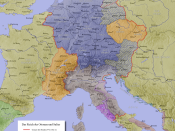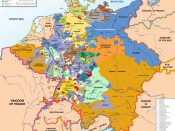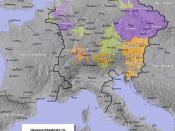The war began with the resistance and eventual revolt of Protestant nobles in Bohemia, which was under Hapsburg domination, against the Catholic King Ferdinand. It spread through Europe because of the constitutional frailty of the Holy Roman Empire, the inability of the German states to act in concert, and the ambitions of other European powers. The Catholic Princes were opposed to the Emperor. The Protestant rulers were divided among themselves between Lutheranism and Calvinism, and many of them were at odds for purely political reasons. Any quarrel among any of the Princes, or between one of them and the emperor, was bound to feed upon heated antagonism and involved them all.
A dispute in Bohemia precipitated the conflict. The Catholic King Ferdinand violated the "Letter of Majesty." This resulted in the revolt of the Czechs in Bohemia. Thus began a war that lasted 30 years. The ensuing conflict came to be known as "The Bohemian Period" (1618-1625) or the Thirty Years' War.
The Protestants elected Frederic as King of Bohemia. Later with the help of the Emperor, the Protestant forces were defeated. Their properties were snatched and distributed among the Catholics. So Protestantism largely disappeared in Bohemia.
As the war dragged on diplomats from all over Europe assembled in Duchy of Westphalia and engaged in the first general peace conference in European History. The treaty of Westphalia was signed in 1648. Territories were given to Sweden, France and Bavaria. Switzerland was formally declared separated from the Empire. The treaty not only brought an end to the Thirty Years' War but also destroyed Germany. Germany was rendered economically bankrupt and politically dismembered, divided into about 350 big
and small states. German princes were made free in internal and external affairs. They arranged and looked after their own army, judiciary...



Thought
I think this essay could be expanded as not all the main points/aspects of the thirty years war was explained. However, all in all it was a good essay and perhaps a start to a higher level paper.
3 out of 3 people found this comment useful.